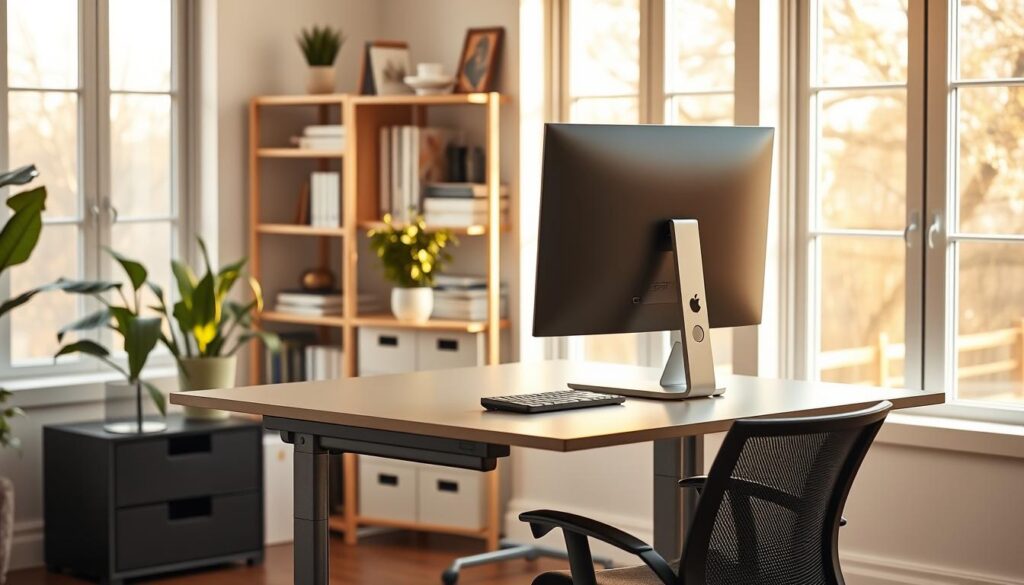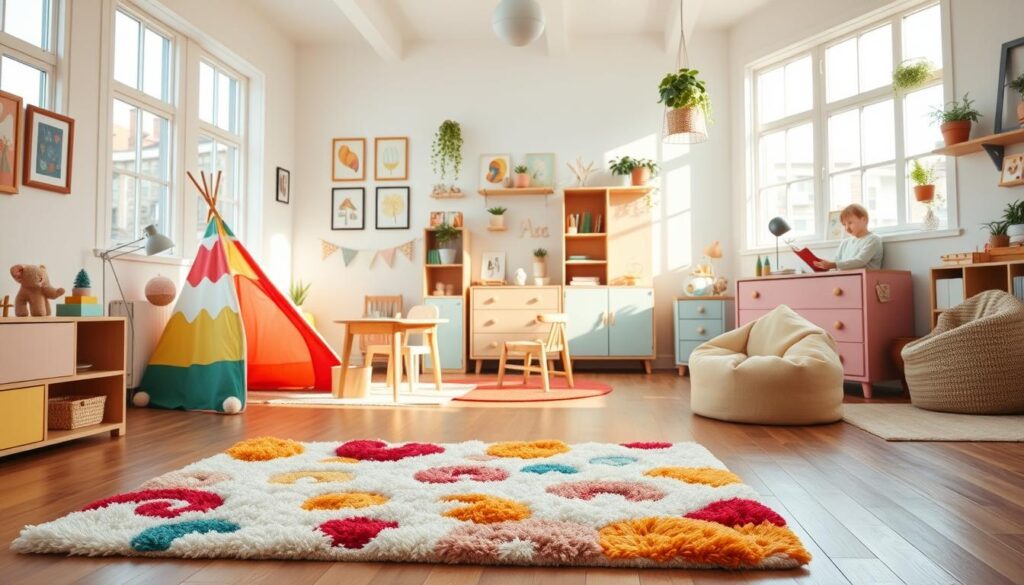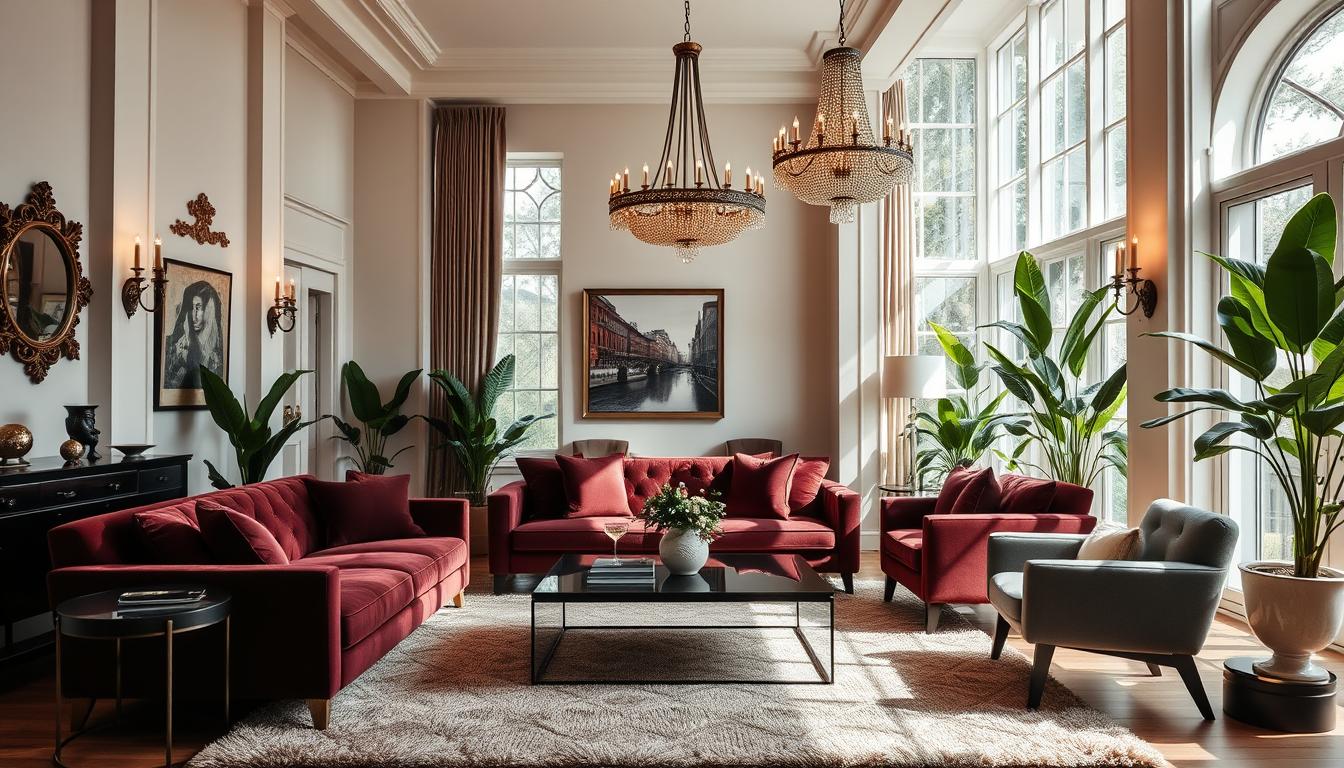Did you know a well-designed living space can make you happier and more productive? Creating a stylish home interior is more than just looks. It’s about making a space that shows off your personality and style.
We’ll dive into the best home interior decoration ideas to turn your space into a cozy and elegant retreat. Whether you love modern simplicity or vintage flair, our top picks will help you create a space that’s both stunning and practical.
Key Takeaways
- Discover the latest trends in stylish home interiors
- Learn how to create a cohesive look in your living space
- Explore different decoration ideas to suit your style
- Find out how to balance form and function in your home
- Get tips on how to make your space feel more inviting
1. Creating a Welcoming Entryway
Your home’s entryway is more than just a passageway. It’s a chance to make a lasting impression. A well-designed entryway sets the tone for your home, showing off your personal style and aesthetic.
To make a welcoming entryway, think about lighting, furniture, and personal touches. Let’s look at how to mix these elements for a great first impression.
1.1 Choosing the Right Lighting
Lighting is key in setting the mood of your entryway. It lights up the space and highlights your home’s best features. For a warm welcome, use a mix of light sources.
- Use overhead lighting to brighten the space.
- Add table lamps or floor lamps for warmth and depth.
- Consider a dimmer switch to change the lighting as the day goes on.
For more interior design tips, check out our blog on 25 gorgeous entryway decor ideas to impress your guests.
1.2 Selecting Functional Furniture
Furniture in the entryway should be both useful and look good. Start with a console table or bench for keys, mail, and more.
| Furniture Piece | Functionality | Aesthetic Appeal |
|---|---|---|
| Console Table | Storage for keys and mail | Displays decorative items |
| Bench | Seating for putting on shoes | Adds a cozy touch |
| Mirror | Last-minute check before leaving | Creates the illusion of a larger space |
1.3 Adding Personal Touches
Personal touches make your entryway special. Add artwork, family photos, or decorative pieces that show your home decor inspiration.
Some ideas include:
- A statement piece of art or a collection of framed photos.
- A decorative vase or a bowl for seasonal decorations.
- A rug that adds warmth and texture to the space.
By combining lighting, functional furniture, and personal touches, you can create an entryway that welcomes guests and shows off your style.
2. Embracing Open Concept Living
Open concept design is a top room makeover idea for making our living areas bigger. It’s popular because it makes our homes feel more open and airy. By removing walls, we get a bigger, more open space.
Open concept living lets us move around easily and spend more time with family and friends. It also makes it easier to change up our furniture and decor.
2.1 Benefits of Open Spaces
Open concept living has many benefits:
- More natural light, thanks to fewer walls.
- Better social interaction, as it encourages talking and being together.
- A bigger feel, even in smaller homes.
Let’s look at how open concept living compares to traditional layouts:
| Feature | Traditional Layout | Open Concept |
|---|---|---|
| Natural Light | Limited by walls and separate rooms | Maximized throughout the space |
| Social Interaction | Can be hindered by separate rooms | Encouraged through open layout |
| Flexibility | Limited by fixed room structures | Offers more flexibility in furniture arrangement |
2.2 Color Schemes for Cohesion
Choosing the right color scheme is key for an open concept space. A harmonious palette can make the space stylish and cohesive.
Here are some tips for a cohesive color scheme:
- Choose a main color and use its variations throughout.
- Use a neutral base color to connect different areas.
- Follow the 60-30-10 rule: 60% main color, 30% secondary, and 10% accent.
By embracing open concept living and picking a cohesive color scheme, we can create a beautiful, functional home. It will reflect the latest interior decorating trends.
3. Incorporating Natural Elements
Natural elements are key to making our homes welcoming and stylish. They add depth and warmth to our living spaces.
3.1 Using Indoor Plants
Indoor plants purify the air and bring nature inside. Choose plants that fit your home’s lighting and care needs.
Benefits of Indoor Plants:
- Improved air quality
- Aesthetic appeal
- Stress reduction
3.2 Choosing Natural Materials
Materials like wood, stone, and bamboo warm up our homes. Think about their durability and how they’ll look over time.
Popular Natural Materials:
- Reclaimed wood for furniture
- Stone or brick for feature walls
- Bamboo for flooring or decorative accents
Using natural elements like plants and materials makes our homes more inviting. This approach to decorating is good for our health and the planet.
4. Personalizing with Artwork
Artwork is more than just decoration. It shows who we are and what we like. The right pieces can make our homes truly reflect our personalities.
Selecting the Right Pieces
Choosing artwork that matches our style is key. We should pick pieces that look good to us and share our interests and values.
- Choose artwork that speaks to your personal experiences or hobbies.
- Consider the color palette of the room and select artwork that complements it.
- Mix different styles and textures to create a unique and personalized look.
Arranging Gallery Walls
Creating a gallery wall is a fun way to show off our favorite art. Here are some tips to make it look great:
- Start with a central piece and build around it.
- Play with different frame styles and sizes to add depth.
- Keep the spacing between frames consistent for a cohesive look.
| Artwork Type | Room Style | Impact |
|---|---|---|
| Abstract Painting | Modern Living Room | Adds a touch of sophistication and elegance |
| Black and White Photography | Minimalist Bedroom | Creates a calm and serene atmosphere |
| Colorful Prints | Playful Kids’ Room | Injects energy and playfulness into the space |
By picking and arranging artwork carefully, we can make our homes truly our own. It’s about finding the right mix and enjoying the journey.
5. Experimenting with Color Palettes
Exploring interior decorating trends, we find that color palettes are key. They transform a room in a big way.
Color palettes can change a room’s feel. They can make it feel fresh, modern, or cozy. Choosing between bold and subtle colors is important. It sets the room’s mood.
Bold vs. Subtle Colors
Bold colors add drama to a room. They make a statement. Subtle colors, on the other hand, bring calm and serenity. They make a space feel relaxed and welcoming.
When picking between bold and subtle colors, think about the room’s purpose and the mood you want. For example, bold reds are great for dining rooms to spark conversation. Soft blues and greens are better for bedrooms to help you relax.
| Color Type | Ideal Room | Mood Created |
|---|---|---|
| Bold Colors | Dining Room, Living Room | Energetic, Stimulating |
| Subtle Colors | Bedroom, Study | Calm, Serene |
Accent Walls and Their Impact
Accent walls are a smart way to add a bold color without overwhelming the room. Painting one wall in a contrasting color creates a focal point. It adds visual interest.
Accent walls can also make a room feel deeper or hide less appealing parts. The trick is to balance the bold accent wall with softer colors on other walls. This prevents the room from feeling too busy.
Playing with color palettes, whether bold or subtle, or using accent walls, is fun and creative. It’s a way to update your home’s look. By thinking about each room’s mood and purpose, you can make choices that improve your living space.
6. Designing Functional Home Offices
Working from home has made designing a good home office very important. A well-designed office helps you stay productive, comfortable, and balanced.
When setting up your home office, think about ergonomic furniture and good organization. We’ll look at how to pick the right furniture and organize your space.
Ergonomic Furniture Choices
Ergonomic furniture helps avoid discomfort and fatigue. Here’s what to look for in your home office furniture:
- Chair Height and Lumbar Support: Your chair should be adjustable and support your lower back well.
- Desk Height: Your desk should be at a height that lets you work with your elbows at 90 degrees.
- Monitor Placement: Place your monitor in front of you, about 20-25 inches away, and slightly below eye level.

Organizing for Productivity
Good organization is essential for a productive home office. Here are some creative design solutions to improve your space:
- Cable Management: Use cable organizers or zip ties to keep your area tidy.
- Storage Solutions: Get shelving or file cabinets for your papers and supplies.
- Task Lighting: Make sure you have enough light for your tasks. A desk lamp can help.
By using these home interior decoration ideas, you can make a home office that’s both useful and nice to work in.
Creating a good home office is an investment in your work and health. Take time to think about what you need and use these tips to make a space that works for you.
7. Crafting Cozy Reading Nooks
A cozy reading nook is more than a comfy chair; it’s a place to relax. We all need a spot to unwind and dive into a book. To make such a space, we must think about furniture and lighting carefully.
Ideal Furniture Selection
Choosing the right furniture is key for a cozy reading nook. Start with a plush armchair or a chaise lounge. Pick something that supports long reading sessions without discomfort.
A recliner with a footrest is a great option. For more ideas, explore different designs and layouts.
Don’t forget a side table or stool for your books and drinks. Textiles like throw blankets also add to the coziness.
Lighting Solutions for Comfort
Lighting is crucial for a cozy feel. We want soft, warm light, not harsh or bright. Table lamps or floor lamps with dimmers are perfect.
They should create a warm glow that invites you in.
Let’s look at some lighting options for comfort:
| Lighting Type | Description | Benefits |
|---|---|---|
| Table Lamps | Placed on side tables, providing focused light. | Easy to adjust, creates a cozy atmosphere. |
| Floor Lamps | Standing lamps that can light up a larger area. | Can be dimmed, adds warmth to the room. |
| String Lights | Decorative lights that add a warm glow. | Creates a relaxing ambiance, aesthetically pleasing. |
By picking the right furniture and lighting, we can make a cozy reading nook. It becomes a perfect place for relaxation and reading.
8. Styling Kids’ Rooms Creatively
Turning a kid’s room into a creative and fun space needs careful planning. It’s important to make a room that sparks imagination and grows with the child. This ensures the room stays exciting and useful as the child gets older.
8.1 Incorporating Playful Themes
Adding playful themes to a kid’s room is easy with the right design elements. Colorful wall decals, themed bedding, and creative lighting fixtures can make the room feel lively. For example, a space-themed room can have glow-in-the-dark stars and planets for an amazing experience.

8.2 Storage Solutions for Clutter
Good storage is key in kids’ rooms to keep things tidy. Using multi-functional furniture like storage beds and desks with drawers helps a lot. Also, colorful storage bins and baskets help kids keep their stuff organized.
With these storage ideas, we can make a room that’s neat and encourages creativity and play.
9. Outdoor Living Spaces Enhancement
Outdoor living spaces are an extension of our homes. They offer a chance to mix function with beauty. We focus on durable elements and activities they support.
Weather-Resistant Furniture
Choosing the right furniture is key for outdoor spaces. We look for pieces that are stylish and weather-proof. Materials like recycled plastic, teak, and synthetic wicker are top picks. They’re durable and easy to care for.
Key Features of Weather-Resistant Furniture:
- Durable materials that withstand weather conditions
- Low maintenance requirements
- Style that complements the home’s interior decoration
| Material | Durability | Maintenance |
|---|---|---|
| Recycled Plastic | High | Low |
| Teak | High | Medium |
| Synthetic Wicker | Medium | Low |
Creating Zones for Activities
To make the most of our outdoor spaces, we can set up different zones. This could be for dining, lounging, or gardening. By doing this, we boost the space’s function and fun.
Considerations for Activity Zones:
- Purpose of the zone (dining, lounging, gardening)
- Furniture and decor that support the zone’s purpose
- Integration with the overall outdoor design
By using weather-resistant furniture and setting up zones, we greatly improve our outdoor spaces. They become valuable parts of our homes.
10. Upscaling with Smart Home Features
Technology is a big part of the latest interior decorating trends. It makes our homes not just functional but also stylish. Adding smart home features can really make our living spaces stand out.
Smart home tech has grown a lot in recent years. It offers many innovative solutions for our daily lives. From voice-controlled lights to advanced security systems, these technologies make our homes better.
Enhancing Daily Life
Smart home features can make our daily routines easier. For example, smart thermostats learn our temperature likes and adjust it for us. Smart lights can even mimic a sunrise or sunset.
Style Meets Functionality
When decorating our homes, we need to balance style and function. Smart home features should add to our home’s look, not take away from it. Choosing sleek, modern devices helps create a unified style that shows off our taste.



